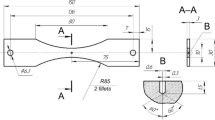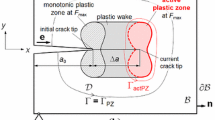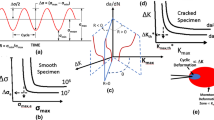Abstract
A discussion is presented of the fatigue process as one of initiating a crack and propagating it to failure, and a formula is presented for estimating the effective point of crack initiation. This formula is speculatively applied to three interface problems in fatigue: (a) Life of a quasi-brittle material which can sustain only a relatively small crack before failure takes place according to the laws of fracture mechanics. An example is presented to illustrate the procedure and to indicate the probable validity of the approach. (b) Estimation of the fatigue characteristics at high temperatures within the creep range of materials. By assuming that intercrystalline cracking has the effect of by-passing much of the crack initiation process, the number of cycles to failure becomes related more importantly to the crack propagation period. A numerical procedure for estimating life in terms of applied strain range is described, and its validity investigated by application to a number of materials for which data have been presented in the literature. (c) Application of a linear damage rule individually to crack initiation and crack propagation. It is possible to predict the effect of order of application of loads in a two-step cumulative fatigue test. The method is checked by using literature data.
Résumé
La discussion présente le phénomène de fatigue agissant dans son processus en deux phases consistant, la première à amorcer une fissure et la seconde à propager cette fissure jusqu'à la cassure; une formule permet d' estimer le point effectif d' amorcage de la fissure. Cette formule permet spéculativement de résoudre trois problèmes de fatigue, ayant des liens communs.
-
a)
Durée de vie d' un matériau tit fragile qui ne supporte qu'une fissure relativement petite avant que la cassure ne se produise suivant les lois de la mécanique de la rupture. Un exemple illustre le procédé et indique les limites probables de la validité de la méthode.
-
b)
Estimation des caractéristiques de fatigue à haute température, dans la zone de fluage des matériaux. En supposant que la formation d' une fissure intercristalline a pour effet de by-passer une grande partie du processus d'amorçage de la fissure, le nombre de cycles qui provoquent la cassure devient relativement plus important que la période de propagation de la fissure. Un procédé numérique, permet de traduire la durée de vie sous forme de tensions appliquées; la valeur de ce procédé est vérifiée par application sur une série de matériaux dont les caractéristiques se retrouvent dans des ouvrages antérieurs.
-
c)
Application d' une loi linéafire de destruction propre à chacune des phases d' amorçage de la fissure et de propagation de la fissure; il est possible de prévoir l'effet de l'ordre d'application des charges dans un essai cumulatig de fatigue, effectué en deux temps. La méthode est vérifiée à l'aide de données publiées dans des ouvrages antérieurs.
Zusammenfassung
Es wird gezeigt, wie der Ermüdungsvorgang zur Entstehung eines Risses und zu dessen Ausdehnung bis zum Bruch führt. Es wird eine Formel zur Abschätzung der effektiven Rissentstehung gegeben und diese Formel versuchsweise angewandt auf drei mit anderen Problemen verkn üpften Ermüdungsprobleme.
-
a)
Lebensdauer eines quasi-spröden Materials, welches nur einen verhältnismässig kleinen Riss vertragen kann, ohne einen Bruch, nach den Gesetzen der Bruch-Mechanik, zu erleiden. Ein Beispiel wird gebracht, um das Verfahren darzustellen und seine wahrscheinliche Gültigkeit aufzuzeigen.
-
b)
Abschätzung der Ermüdungswerte bei hohen Temperaturen und innerhalb des Kriechbereiches der Materiale. Unter der Annahme, dass interkristallinische Risse den Rissentstehungsvorgang weitgehend überbrücken, gewinnt der Zusammenhang zwischen der Anzahl der Lastwechsel bis zum Bruch und der Rissausdehnungsperiode mehr an Bedeutung. Es wird ein numerisches Verfahren zur Abschätzung der Lebensdauer in Abhängigkeit von der aufgedrücken Last beschrieben and die Gültigkeit dieser Verfahrens durch Anwendung auf einige Materiale, über die Daten in der Literatur veröffentlicht wurden, untersucht.
-
c)
Bei Anwendung eines linearen Zerstörungsgesetzes sowohl auf Rissentstehung, als auch auf Risserweitering fist es möglich, den Einfluss der Reihenfolge der aufgedrücken Belastungen in einem zweistufigen, kumulativen Ermüdungsversuch vorherzusagen. DieMethode wird anhand von in der Literatur veröffentlichen Daten geprüft.
Similar content being viewed by others
References
S.S.Manson Exp. Mech.,5, 7, 193–226 (July 1965).
S.S.Manson; M. H. Hirschberg “Crack Initiation and Propagation in Notched Fatigue Specimens. ”(Proposed NASA Technical Note)
S.S.Manson Proc. of Heat Transfer Symp., Univ. of Mich. Press. 9–76 (1953). (Also available as “Behavior of Materials Under Conditions of Thermal Stress,” NACA TN-2933 (1953)).
L.F.Coffin,Jr. Trans.ASME,76, 931–950 (August 1954).
R.W.Smith; M.H.Hirschberg; S.S.Manson “Fatigue Behavior of Materials Under Strain Cycling in Low and Intermediate Life Range”, NASA TN D-1574 (1963).
J.F.Tavernelli; L.F.Coffin,Jr. J.Basic Engr.,84, 4, 533–537 (Dec.1962). (Disc. by S.S.Manson, pp. 5372–541.)
S.S.Manson; M.H.Hirschberg Proc.Tenth Sagamore Army Matls.Research. Conf., J.J.Burke, N.L.Reed, and V. Weiss, eds., Syracuse. Univ. Press, 133–178 (1964).
S.S.MansonMaterials Under Thermal Stress and Low Cycle Fatigue, Chap. 4, McGraw-Hill Book Co. (1966).
J.E.Srawley; W.F.Brown,Jr.Fracture Toughness Testing and Its Application, Spec. Tech. Publ. No. 381,. ASTM, 133–198 (1965).
J.M.Krafft Trans. ASM,58, 4, 691–695 (Dec. 1965).
L.F.Coffin,Jr. “Cyclic Strain and Fatigue Behavior of Metals in the Creep Range, presented at Int.Conf. Fracture, Sendai, Japan (1965).
W.A.Wood; H.D.Nine “Differences in Fatigue Behavior of Single Corner Crystals and Polycrystalline Copper at Elevated Temperatures,” Dept. of Civil Engr. and Engr. Mech., Columbia Univ. February 1965), (Also available from DDC as AD 612 713.)
P.J.E.Forsyth Acta Met.,11, 7, 703–715 (July 1963).
W.A.Wood; S.M.Cousland; K.R.Sargant Acta Met.,11, 7, 643–652 (July 1963).
J.E.Dom; L.A.ShepardSymp: Effect.of Cyclic Heating and Stressing on, Metals at Elevated Temperatures; Spec. Tech. Publ. No. 165, ASTM, 3–30 (1954).
P.G.Forrest; K.B.Armstrong Joint Int. Conf. on Creep, Aug. 25–29 and Sept. 30–Oct. 4, 1963, Inst. Mech. Engr. (London), 3-1 to 3-7 (1963).
A.Coles; JSkinner J.Roy.Aeron.Soc.,69, 649, 53–55 (Jan.1965).
A.E.Carden J.Basic Engr.,87, 1, 237–244 (March 1965)
L.F.Coffin,Jr. AIME Met.Soc.Trans.,230, 7, 1690–1699 (Dec. 1964).
G.R.Gohn; W.C.Ellis Proc.ASTM,51, 721–744 (1951).
A.Palmgren ZVDI,68, 14, 339–341 (April 1924).
B.F.Langer J. Appl. Mech.,4, 4, A160-A162 (Dec. 1937).
M.A.Miner J. Appl. Mech.,12, 3, A159-A164 (Sept.1945).
W.WeibullFatigue Testing and Analysis of Results, Pergamon Press, 132 (1961).
S.S.Manson; A.J.Nachtigall; C.R.Ensign; J.C.Freche J. Engr. Ind.,87, 1, 25–35 (Feb. 1965).
F.C.Rally; G.M.Sinclair “Influence of Strain Aging on the Shape of the S-N Diagram,” Report No. 87,Dept. of and Appl. Mech., Univ. of Illunois (June 1955).
H.J.GroverSymp.on Fatigue of Aircraft Structures, Spec. Tech. Publ.No.274. ASTM, 120–124 (1960).
S.S.Manson; A.J.Nachtigall; J.C.Freche Proc.ASTM,61, 679–703 (1961).
R.C.Boettner; C.Laird; A.J.McEvily,Jr. Trans.AIME,233, 2, 379–387 (Feb.1965).
V.Weiss Proc.Tenth Sagamore Amy Matls. Research Conf., J.J.Burke, N.L.Reed, and V.Weiss, eds., Syracuse Univ.Press, 179–186 (1964).
Author information
Authors and Affiliations
Rights and permissions
About this article
Cite this article
Manson, S.S. Interfaces between fatigue, creep, and fracture. Int J Fract 2, 327–363 (1966). https://doi.org/10.1007/BF00698478
Issue Date:
DOI: https://doi.org/10.1007/BF00698478




